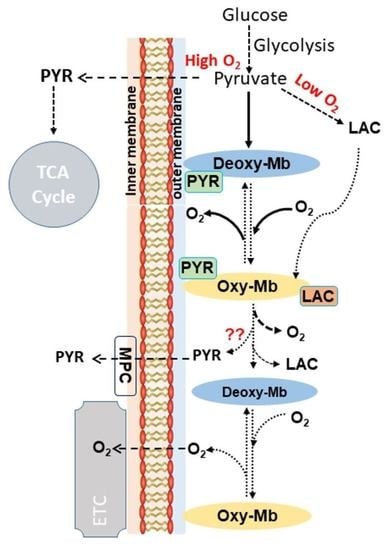Myoglobin–Pyruvate Interactions: Binding Thermodynamics, Structure–Function Relationships, and Impact on Oxygen Release Kinetics
Abstract
1. Introduction
2. Results and Discussion
3. Materials and Methods
3.1. Materials
3.2. Preparation of Mb
3.3. Ligand Binding Studies
3.4. Oxygen Release Kinetic Studies
3.5. Circular Dichroism Spectroscopic Studies
3.6. Molecular Docking
3.7. Statistical Analysis
4. Conclusions
Supplementary Materials
Author Contributions
Funding
Institutional Review Board Statement
Informed Consent Statement
Data Availability Statement
Acknowledgments
Conflicts of Interest
Abbreviations
| deoxy-Mb | deoxygenated myoglobin |
| Mb | myoglobin |
| oxy-Mb | oxygenated myoglobin |
| LAC | sodium lactate |
| PYR | sodium pyruvate |
References
- Chandel, N.S. Glycolysis. Cold Spring Harb. Perspect. Biol. 2021, 13, a040535. [Google Scholar] [CrossRef]
- Ong, H.Y.; O’Dochartaigh, C.S.; Lovell, S.; Patterson, V.H.; Wasserman, K.; Nicholls, D.P.; Riley, M.S. Gas exchange responses to constant work-rate exercise in patients with glycogenosis type V and VII. Am. J. Respir. Crit. Care Med. 2004, 169, 1238–1244. [Google Scholar] [CrossRef]
- Constantin-Teodosiu, D.; Peirce, N.S.; Fox, J.; Greenhaff, P.L. Muscle pyruvate availability can limit the flux, but not activation, of the pyruvate dehydrogenase complex during submaximal exercise in humans. J. Physiol. 2004, 561, 647–655. [Google Scholar] [CrossRef]
- Fukui, H.; Taniguchi, S.; Ueta, Y.; Yoshida, A.; Ohtahara, A.; Hisatome, I.; Shigemasa, C. Enhanced activity of the purine nucleotide cycle of the exercising muscle in patients with hyperthyroidism. J. Clin. Endocrinol. Metab. 2001, 86, 2205–2210. [Google Scholar] [CrossRef][Green Version]
- Voet, D.; Voet, J.G.; Pratt, C.W. Fundamentals of Biochemistry Life at the Molecular Level; Wiley: Hoboken, NJ, USA, 2016. [Google Scholar]
- Brooks, G.A. The Science and Translation of Lactate Shuttle Theory. Cell Metab. 2018, 27, 757–785. [Google Scholar] [CrossRef]
- Rabinowitz, J.D.; Enerback, S. Lactate: The ugly duckling of energy metabolism. Nat. Metab. 2020, 2, 566–571. [Google Scholar] [CrossRef]
- Mendes-Mourao, J.; Halestrap, A.P.; Crisp, D.M.; Pogson, C.I. The involvement of mitochondrial pyruvate transport in the pathways of gluconeogenesis from serine and alanine in isolated rat and mouse liver cells. FEBS Lett. 1975, 53, 29–32. [Google Scholar] [CrossRef]
- Hopper, S.; Segal, H.L. Comparative Properties of Glutamic-Alanine Transaminase from Several Sources. Arch. Biochem. Biophys. 1964, 105, 501–505. [Google Scholar] [CrossRef]
- Prochownik, E.V.; Wang, H. The Metabolic Fates of Pyruvate in Normal and Neoplastic Cells. Cells 2021, 10, 762. [Google Scholar] [CrossRef]
- Plotnikov, E.Y.; Chupyrkina, A.A.; Pevzner, I.B.; Isaev, N.K.; Zorov, D.B. Myoglobin causes oxidative stress, increase of NO production and dysfunction of kidney’s mitochondria. Biochim. Biophys. Acta 2009, 1792, 796–803. [Google Scholar] [CrossRef]
- Park, J.W.; Piknova, B.; Dey, S.; Noguchi, C.T.; Schechter, A.N. Compensatory mechanisms in myoglobin deficient mice preserve NO homeostasis. Nitric Oxide 2019, 90, 10–14. [Google Scholar] [CrossRef]
- Nakamura, M.; Nakamura, S. Conversion of metmyoglobin to NO myoglobin in the presence of nitrite and reductants. Biochim. Biophys. Acta 1996, 1289, 329–335. [Google Scholar] [CrossRef]
- Eich, R.F.; Li, T.; Lemon, D.D.; Doherty, D.H.; Curry, S.R.; Aitken, J.F.; Mathews, A.J.; Johnson, K.A.; Smith, R.D.; Phillips, G.N., Jr.; et al. Mechanism of NO-induced oxidation of myoglobin and hemoglobin. Biochemistry 1996, 35, 6976–6983. [Google Scholar] [CrossRef]
- Moller, J.K.; Skibsted, L.H. Nitric oxide and myoglobins. Chem. Rev. 2002, 102, 1167–1178. [Google Scholar] [CrossRef]
- Cossins, A.; Berenbrink, M. Physiology: Myoglobin’s new clothes. Nature 2008, 454, 416–417. [Google Scholar] [CrossRef]
- Tichivangana, J.Z.; Morrissey, P.A. Metmyoglobin and inorganic metals as pro-oxidants in raw and cooked muscle systems. Meat Sci. 1985, 15, 107–116. [Google Scholar] [CrossRef]
- Galaris, D.; Sevanian, A.; Cadenas, E.; Hochstein, P. Ferrylmyoglobin-catalyzed linoleic acid peroxidation. Arch. Biochem. Biophys. 1990, 281, 163–169. [Google Scholar] [CrossRef]
- Chan, W.K.; Faustman, C.; Yin, M.; Decker, E.A. Lipid oxidation induced by oxymyoglobin and metmyoglobin with involvement of H(2)O(2) and superoxide anion. Meat Sci. 1997, 46, 181–190. [Google Scholar] [CrossRef]
- Baron, C.P.; Skibsted, L.H.; Andersen, H.J. Concentration effects in myoglobin-catalyzed peroxidation of linoleate. J. Agric. Food Chem. 2002, 50, 883–888. [Google Scholar] [CrossRef]
- Baron, C.P.; Andersen, H.J. Myoglobin-induced lipid oxidation. A review. J. Agric. Food Chem. 2002, 50, 3887–3897. [Google Scholar] [CrossRef]
- Vuletich, J.L.; Osawa, Y.; Aviram, M. Enhanced lipid oxidation by oxidatively modified myoglobin: Role of protein-bound heme. Biochem. Biophys. Res. Commun. 2000, 269, 647–651. [Google Scholar] [CrossRef]
- Chintapalli, S.V.; Bhardwaj, G.; Patel, R.; Shah, N.; Patterson, R.L.; van Rossum, D.B.; Anishkin, A.; Adams, S.H. Molecular dynamic simulations reveal the structural determinants of Fatty Acid binding to oxy-myoglobin. PLoS ONE 2015, 10, e0128496. [Google Scholar] [CrossRef]
- Gloster, J.; Harris, P. Fatty acid binding to cytoplasmic proteins of myocardium and red and white skeletal muscle in the rat. A possible new role for myoglobin. Biochem. Biophys. Res. Commun. 1977, 74, 506–513. [Google Scholar] [CrossRef]
- Gotz, F.M.; Hertel, M.; Groschel-Stewart, U. Fatty acid binding of myoglobin depends on its oxygenation. Biol. Chem. Hoppe-Seyler 1994, 375, 387–392. [Google Scholar] [CrossRef]
- Sriram, R.; Kreutzer, U.; Shih, L.; Jue, T. Interaction of fatty acid with myoglobin. FEBS Lett. 2008, 582, 3643–3649. [Google Scholar] [CrossRef]
- Jue, T.; Shih, L.; Chung, Y. Differential Interaction of Myoglobin with Select Fatty Acids of Carbon Chain Lengths C8 to C16. Lipids 2017, 52, 711–727. [Google Scholar] [CrossRef]
- Schlater, A.E.; De Miranda, M.A., Jr.; Frye, M.A.; Trumble, S.J.; Kanatous, S.B. Changing the paradigm for myoglobin: A novel link between lipids and myoglobin. J. Appl. Physiol. 2014, 117, 307–315. [Google Scholar] [CrossRef]
- Chintapalli, S.V.; Anishkin, A.; Adams, S.H. Exploring the entry route of palmitic acid and palmitoylcarnitine into myoglobin. Arch. Biochem. Biophys. 2018, 655, 56–66. [Google Scholar] [CrossRef]
- Chintapalli, S.V.; Jayanthi, S.; Mallipeddi, P.L.; Gundampati, R.; Suresh Kumar, T.K.; van Rossum, D.B.; Anishkin, A.; Adams, S.H. Novel Molecular Interactions of Acylcarnitines and Fatty Acids with Myoglobin. J. Biol. Chem. 2016, 291, 25133–25143. [Google Scholar] [CrossRef]
- Giardina, B.; Ascenzi, P.; Clementi, M.E.; De Sanctis, G.; Rizzi, M.; Coletta, M. Functional modulation by lactate of myoglobin. A monomeric allosteric hemoprotein. J. Biol. Chem. 1996, 271, 16999–17001. [Google Scholar] [CrossRef]
- Adepu, K.K.; Bhandari, D.; Anishkin, A.; Adams, S.H.; Chintapalli, S.V. Myoglobin Interaction with Lactate Rapidly Releases Oxygen: Studies on Binding Thermodynamics, Spectroscopy, and Oxygen Kinetics. Int. J. Mol. Sci. 2022, 23, 4747. [Google Scholar] [CrossRef]
- Olsson, M.H.; Sondergaard, C.R.; Rostkowski, M.; Jensen, J.H. PROPKA3: Consistent Treatment of Internal and Surface Residues in Empirical pKa Predictions. J. Chem. Theory. Comput. 2011, 7, 525–537. [Google Scholar] [CrossRef]
- Ono-Moore, K.D.; Olfert, I.M.; Rutkowsky, J.M.; Chintapalli, S.V.; Willis, B.J.; Blackburn, M.L.; Williams, D.K.; O’Reilly, J.; Tolentino, T.; Lloyd, K.C.K.; et al. Metabolic physiology and skeletal muscle phenotypes in male and female myoglobin knockout mice. Am. J. Physiol. Endocrinol. Metab. 2021, 321, E63–E79. [Google Scholar] [CrossRef]
- Blackburn, M.L.; Wankhade, U.D.; Ono-Moore, K.D.; Chintapalli, S.V.; Fox, R.; Rutkowsky, J.M.; Willis, B.J.; Tolentino, T.; Lloyd, K.C.K.; Adams, S.H. On the potential role of globins in brown adipose tissue: A novel conceptual model and studies in myoglobin knockout mice. Am. J. Physiol. Endocrinol. Metab. 2021, 321, E47–E62. [Google Scholar] [CrossRef]
- Proia, P.; Di Liegro, C.M.; Schiera, G.; Fricano, A.; Di Liegro, I. Lactate as a Metabolite and a Regulator in the Central Nervous System. Int. J. Mol. Sci. 2016, 17, 1450. [Google Scholar] [CrossRef]
- Henderson, G.C.; Horning, M.A.; Wallis, G.A.; Brooks, G.A. Pyruvate metabolism in working human skeletal muscle. Am. J. Physiol. Endocrinol. Metab. 2007, 292, E366. [Google Scholar] [CrossRef]
- Turnbull, W.B.; Daranas, A.H. On the value of c: Can low affinity systems be studied by isothermal titration calorimetry? J. Am. Chem. Soc. 2003, 125, 14859–14866. [Google Scholar] [CrossRef]
- Tuesdale, G.A.; Downing, A.L. Solubility of oxygen in water. Nature 1954, 173, 1236. [Google Scholar] [CrossRef]
- Morris, G.M.; Huey, R.; Lindstrom, W.; Sanner, M.F.; Belew, R.K.; Goodsell, D.S.; Olson, A.J. AutoDock4 and AutoDockTools4: Automated docking with selective receptor flexibility. J. Comput. Chem. 2009, 30, 2785–2791. [Google Scholar] [CrossRef]
- Clanton, T.L. Managing the power grid: How myoglobin can regulate PO2 and energy distribution in skeletal muscle. J. Appl. Physiol. 2019, 126, 787–790. [Google Scholar] [CrossRef]
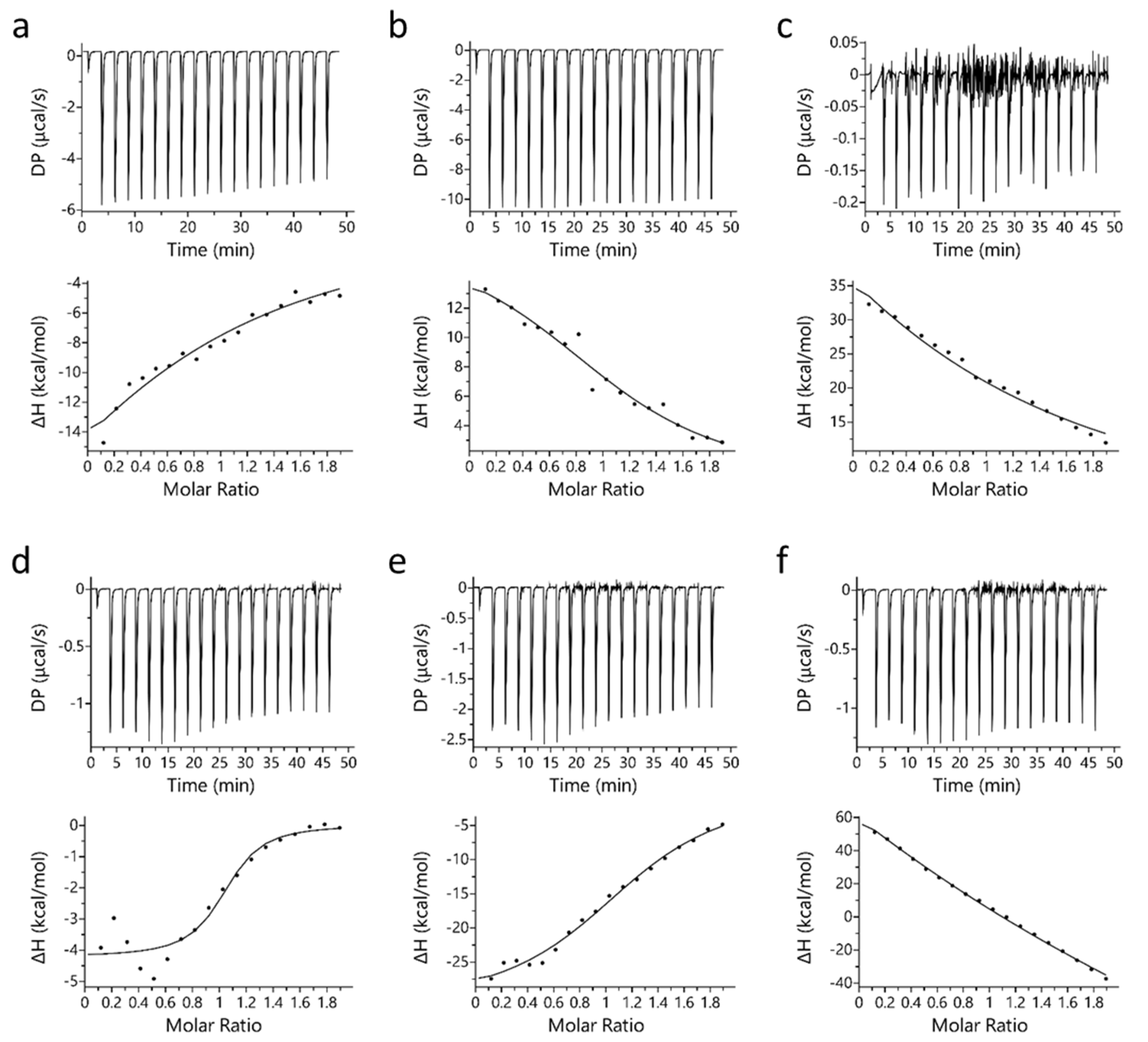
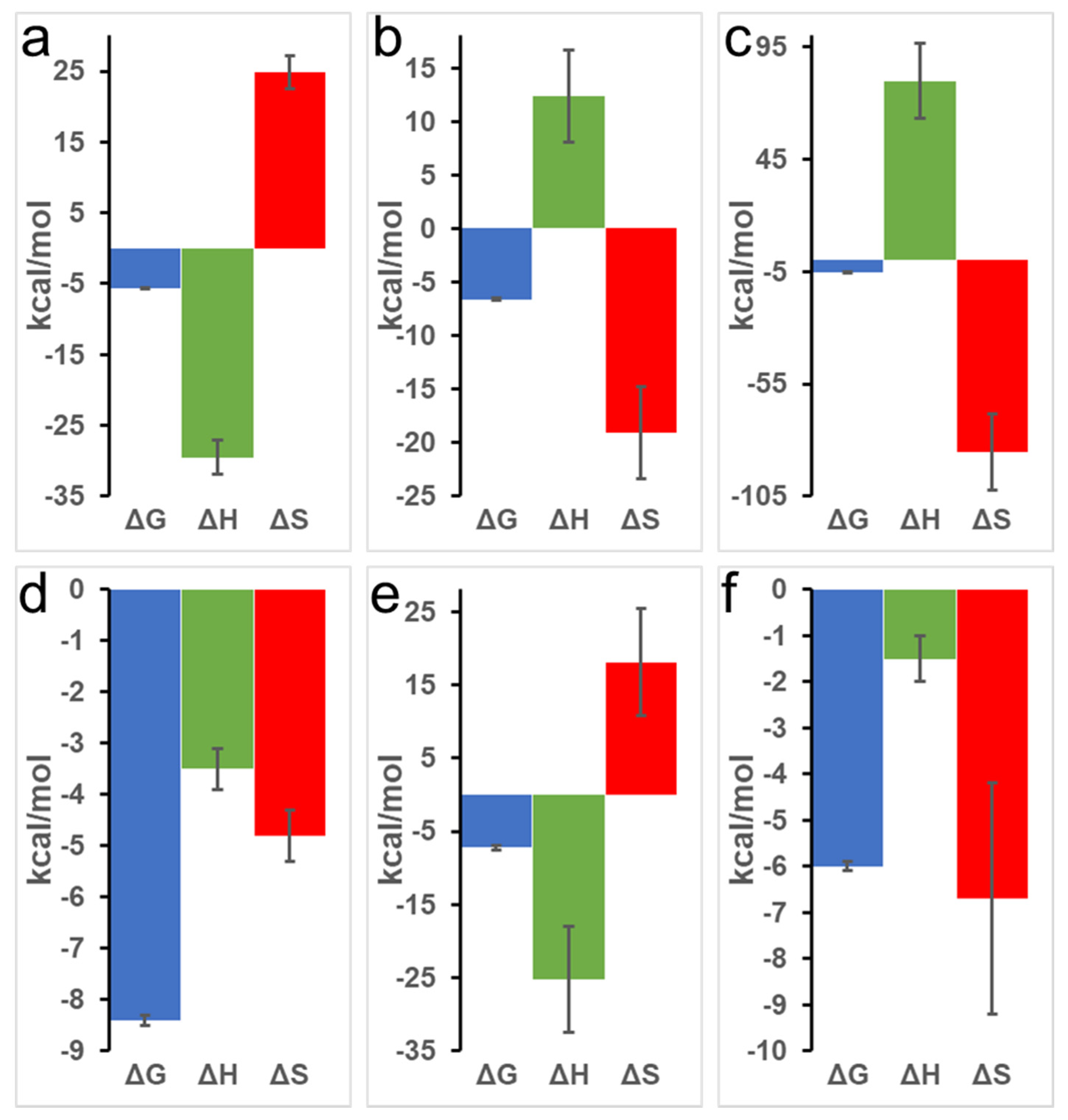
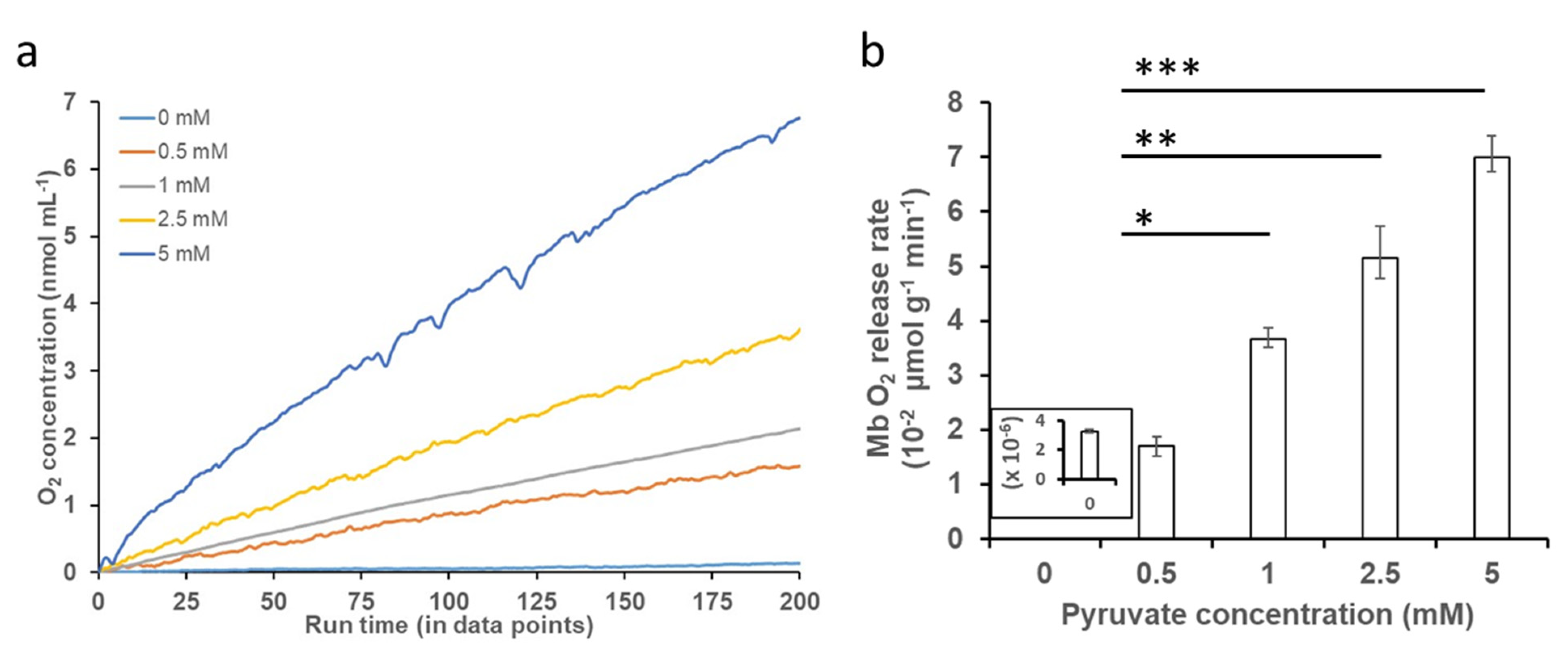

 ) display high affinity and rapid reaction rates and dashed arrows (
) display high affinity and rapid reaction rates and dashed arrows ( ) display lower affinity and slower reaction rates. oxy-Mb: oxygenated-Mb; deoxy-Mb: deoxygenated-Mb; PYR: pyruvate; LAC: lactate; TCA cycle: tricarboxylic acid cycle; ETC: electron transport chain; MPC: mitochondrial pyruvate complex; mLOC: mitochondrial lactate oxidation complex; MCT4: monocarboxylate transporter 4.
) display lower affinity and slower reaction rates. oxy-Mb: oxygenated-Mb; deoxy-Mb: deoxygenated-Mb; PYR: pyruvate; LAC: lactate; TCA cycle: tricarboxylic acid cycle; ETC: electron transport chain; MPC: mitochondrial pyruvate complex; mLOC: mitochondrial lactate oxidation complex; MCT4: monocarboxylate transporter 4.
 ) display high affinity and rapid reaction rates and dashed arrows (
) display high affinity and rapid reaction rates and dashed arrows ( ) display lower affinity and slower reaction rates. oxy-Mb: oxygenated-Mb; deoxy-Mb: deoxygenated-Mb; PYR: pyruvate; LAC: lactate; TCA cycle: tricarboxylic acid cycle; ETC: electron transport chain; MPC: mitochondrial pyruvate complex; mLOC: mitochondrial lactate oxidation complex; MCT4: monocarboxylate transporter 4.
) display lower affinity and slower reaction rates. oxy-Mb: oxygenated-Mb; deoxy-Mb: deoxygenated-Mb; PYR: pyruvate; LAC: lactate; TCA cycle: tricarboxylic acid cycle; ETC: electron transport chain; MPC: mitochondrial pyruvate complex; mLOC: mitochondrial lactate oxidation complex; MCT4: monocarboxylate transporter 4.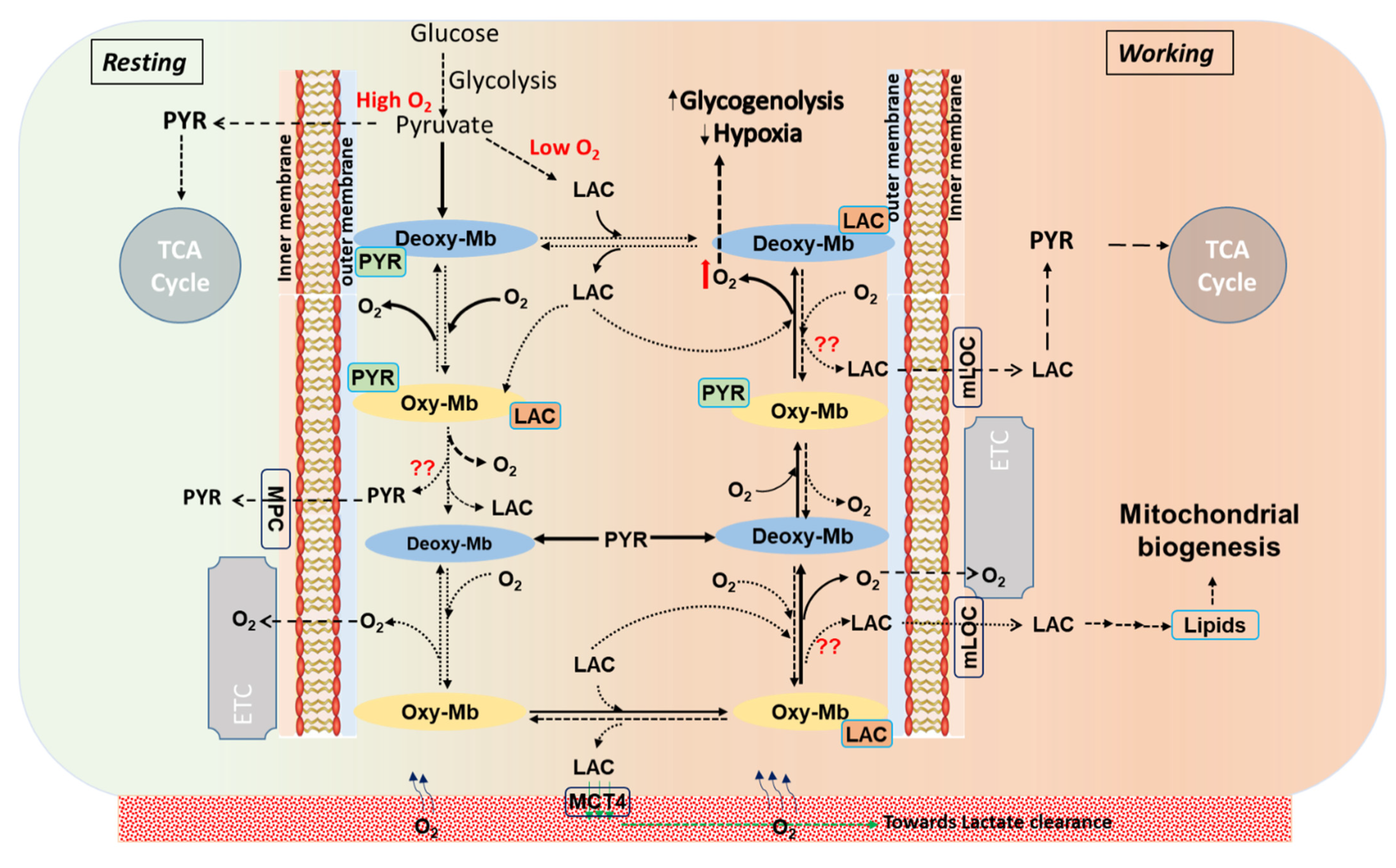
| Thermal Properties | pH 7.0 | pH 6.4 | pH 6.0 | |||
|---|---|---|---|---|---|---|
| Oxy-Mb | Deoxy-Mb | Oxy-Mb | Deoxy-Mb | Oxy-Mb | Deoxy-Mb | |
| Kd (µM) | 77.1 ± 1.7 1 | 0.71 ± 0.11 a | 14.2 ± 1.1 2 | 5.7 ± 1.5 b | 100.8 ± 4.3 3 | 42.4 ± 5.9 c |
| Ka (nM) | 12.9 ± 0.3 1 | 1474 ± 211 a | 71.02 ± 5.0 2 | 218 ± 80 b | 9.95 ± 0.4 3 | 24.4 ± 3.2 c |
| c value | 6.5 ± 0.1 1 | 737 ± 105 a | 35.5 ± 2.5 2 | 109 ± 40 b | 4.9 ± 0.2 3 | 12.2 ± 1.6 c |
| ΔG (kcal mol−1) | −5.6 ± 0.1 1 | −8.4 ± 0.1 a | −6.6 ± 0.1 2 | −7.2 ± 0.3 b | −5.2 ± 0.2 1 | −6.0 ± 0.1 b |
| ΔH (kcal mol−1) | −29.5 ± 2.4 1 | −3.5 ± 0.4 a | 12.4 ± 4.3 2 | −25.2 ± 7.2 b | 79.9 ± 16.7 3 | −1.5 ± 0.5 a |
| ΔS (cal mol−1 K−1) | 24.8 ± 2.3 1 | −4.8 ± 0.5 a | −19.1 ± 4.3 2 | 18.1 ± 7.3 b | −85.5 ± 17 3 | −6.7 ± 2.4 a |
| No. of binding sites | 0.99 ± 0.03 1 | 0.98 ± 0.02 a | 0.81 ± 0.05 1 | 0.88 ± 0.03 a | 0.92 ± 0.07 1 | 1.03 ± 0.04 a |
| Protein State | Metabolite | Metabolite Concentration | pH 7.0 | pH 6.4 | pH 6.0 | |||||||||
|---|---|---|---|---|---|---|---|---|---|---|---|---|---|---|
| α-Helix | β-Sheet | Turn | Others | α-Helix | β-Sheet | Turn | Others | α-Helix | β-Sheet | Turn | Others | |||
| Oxygenated-Mb | Control (0 mM) | 78.4 | 0.0 | 4.2 | 17.4 | 77.9 | 0.0 | 15.4 | 6.7 | 77.7 | 0.0 | 7.8 | 14.5 | |
| PYR | 1 mM | 84.1 | 0.0 | 6.0 | 9.9 | 74.2 | 0.0 | 6.2 | 19.6 | 64.2 | 3.0 | 9.0 | 23.8 | |
| 2 mM | 75.7 | 0.0 | 5.1 | 19.2 | 70.2 | 0.0 | 13.5 | 16.3 | 70.0 | 0.2 | 8.5 | 21.3 | ||
| 3 mM | 80.7 | 0.0 | 6.8 | 12.5 | 73.3 | 0.0 | 10.1 | 16.6 | 75.7 | 0.0 | 9.3 | 15.0 | ||
| 4 mM | 79.4 | 0.0 | 7.3 | 13.3 | 78.6 | 0.0 | 3.5 | 17.9 | 67.9 | 7.6 | 11.5 | 13.0 | ||
| 5 mM | 77.9 | 0.0 | 7.0 | 15.1 | 77.2 | 0.0 | 9.6 | 13.2 | 75.7 | 0.0 | 7.1 | 17.2 | ||
| 6 mM | 80.5 | 0.0 | 11.4 | 8.1 | 79.9 | 0.0 | 10.8 | 9.3 | 78.4 | 0.0 | 11.9 | 9.7 | ||
| 7 mM | 80.2 | 0.0 | 6.6 | 13.2 | 76.7 | 0.0 | 10.0 | 13.3 | 73.1 | 0.0 | 11.6 | 15.3 | ||
| 8 mM | 78.9 | 0.0 | 5.5 | 15.6 | 76.1 | 0.0 | 4.6 | 19.3 | 72.5 | 0.0 | 12.1 | 15.4 | ||
| LAC | 1 mM | 68.5 | 0.0 | 13.2 | 18.3 | 75.5 | 0.0 | 6.9 | 17.6 | 71.5 | 0.0 | 15.3 | 13.2 | |
| 2 mM | 75.5 | 0.0 | 12 | 12.5 | 79.3 | 0.0 | 14.9 | 5.8 | 76.4 | 0.0 | 10.9 | 12.7 | ||
| 3 mM | 75.4 | 0.0 | 11.7 | 12.9 | 76.3 | 0.0 | 6.0 | 17.7 | 70.4 | 0.0 | 7.3 | 22.3 | ||
| 4 mM | 74.6 | 0.0 | 6.5 | 18.9 | 78.3 | 0.0 | 10.9 | 10.8 | 76.4 | 0.0 | 9.0 | 14.6 | ||
| 5 mM | 73.9 | 0.0 | 10.4 | 15.7 | 78.4 | 0.0 | 9.5 | 12.1 | 73.9 | 0.0 | 8.7 | 17.4 | ||
| 6 mM | 76.5 | 0.0 | 14.1 | 9.4 | 79.7 | 0.0 | 8.7 | 11.6 | 73.6 | 0.0 | 8.1 | 18.3 | ||
| 7 mM | 78.6 | 0.0 | 8.8 | 12.6 | 82.0 | 0.0 | 6.9 | 11.1 | 76.0 | 0.0 | 8.3 | 15.7 | ||
| 8 mM | 72.7 | 0.0 | 6.6 | 20.7 | 76.2 | 0.0 | 0.5 | 23.3 | 72.9 | 0.0 | 8.9 | 18.2 | ||
| Deoxygenated-Mb | Control (0 mM) | 73.3 | 0.0 | 12.9 | 13.8 | 75.8 | 0.0 | 10.5 | 13.7 | 70.6 | 0.0 | 10.1 | 19.3 | |
| PYR | 1 mM | 78.2 | 0.0 | 7.7 | 14.1 | 80.0 | 0.0 | 13.8 | 6.2 | 75.1 | 0.0 | 7.0 | 17.9 | |
| 2 mM | 72.8 | 0.0 | 9.7 | 17.5 | 70.5 | 0.0 | 12.6 | 16.9 | 74.2 | 0.0 | 8.7 | 17.1 | ||
| 3 mM | 77.7 | 0.0 | 9.9 | 12.4 | 73.7 | 0.0 | 12.5 | 13.8 | 76.4 | 0.0 | 10.0 | 13.6 | ||
| 4 mM | 79.5 | 0.0 | 12.4 | 8.1 | 78.2 | 0.0 | 11.0 | 10.8 | 75.2 | 0.0 | 6.9 | 17.9 | ||
| 5 mM | 74.4 | 0.0 | 10.5 | 15.1 | 77.4 | 0.0 | 8.6 | 14.0 | 76.7 | 0.0 | 8.6 | 14.7 | ||
| 6 mM | 67.9 | 0.0 | 8.4 | 23.7 | 72.9 | 0.0 | 7.1 | 20.0 | 76.5 | 0.0 | 12.3 | 11.2 | ||
| 7 mM | 74.4 | 0.0 | 15.7 | 10.2 | 77.4 | 0.0 | 11.7 | 10.9 | 71.3 | 0.0 | 10.6 | 18.1 | ||
| 8 mM | 72.1 | 0.0 | 9.2 | 20.1 | 73.9 | 0.0 | 7.1 | 19.0 | 72.6 | 0.0 | 5.9 | 21.5 | ||
| LAC | 1 mM | 82.8 | 0.0 | 12.3 | 4.9 | 77.7 | 0.0 | 9.1 | 13.2 | 72.4 | 0.0 | 7.9 | 19.7 | |
| 2 mM | 68.7 | 0.0 | 10.6 | 20.7 | 75.7 | 0.0 | 7.0 | 17.3 | 81.4 | 0.0 | 10.0 | 8.6 | ||
| 3 mM | 78.1 | 0.0 | 9.0 | 12.9 | 80.7 | 0.0 | 12.4 | 6.9 | 78.3 | 0.0 | 11.1 | 10.6 | ||
| 4 mM | 73.3 | 0.0 | 7.2 | 19.5 | 77.3 | 0.0 | 8.9 | 13.8 | 74.7 | 0.0 | 6.1 | 19.2 | ||
| 5 mM | 73.3 | 0.0 | 13.3 | 13.4 | 76.3 | 0.0 | 5.4 | 18.3 | 71.2 | 0.0 | 4.8 | 24.0 | ||
| 6 mM | 70.9 | 0.0 | 6.2 | 22.9 | 80.9 | 0.0 | 10.0 | 9.1 | 73.0 | 0.0 | 9.9 | 17.1 | ||
| 7 mM | 78.0 | 0.0 | 7.6 | 14.4 | 77.7 | 0.0 | 11.4 | 10.9 | 72.6 | 0.0 | 6.0 | 21.4 | ||
| 8 mM | 69.8 | 0.0 | 7.0 | 23.2 | 80.2 | 4.3 | 9.2 | 6.3 | 71.4 | 0.0 | 12.6 | 16.0 | ||
Publisher’s Note: MDPI stays neutral with regard to jurisdictional claims in published maps and institutional affiliations. |
© 2022 by the authors. Licensee MDPI, Basel, Switzerland. This article is an open access article distributed under the terms and conditions of the Creative Commons Attribution (CC BY) license (https://creativecommons.org/licenses/by/4.0/).
Share and Cite
Adepu, K.K.; Bhandari, D.; Anishkin, A.; Adams, S.H.; Chintapalli, S.V. Myoglobin–Pyruvate Interactions: Binding Thermodynamics, Structure–Function Relationships, and Impact on Oxygen Release Kinetics. Int. J. Mol. Sci. 2022, 23, 8766. https://doi.org/10.3390/ijms23158766
Adepu KK, Bhandari D, Anishkin A, Adams SH, Chintapalli SV. Myoglobin–Pyruvate Interactions: Binding Thermodynamics, Structure–Function Relationships, and Impact on Oxygen Release Kinetics. International Journal of Molecular Sciences. 2022; 23(15):8766. https://doi.org/10.3390/ijms23158766
Chicago/Turabian StyleAdepu, Kiran Kumar, Dipendra Bhandari, Andriy Anishkin, Sean H. Adams, and Sree V. Chintapalli. 2022. "Myoglobin–Pyruvate Interactions: Binding Thermodynamics, Structure–Function Relationships, and Impact on Oxygen Release Kinetics" International Journal of Molecular Sciences 23, no. 15: 8766. https://doi.org/10.3390/ijms23158766
APA StyleAdepu, K. K., Bhandari, D., Anishkin, A., Adams, S. H., & Chintapalli, S. V. (2022). Myoglobin–Pyruvate Interactions: Binding Thermodynamics, Structure–Function Relationships, and Impact on Oxygen Release Kinetics. International Journal of Molecular Sciences, 23(15), 8766. https://doi.org/10.3390/ijms23158766





